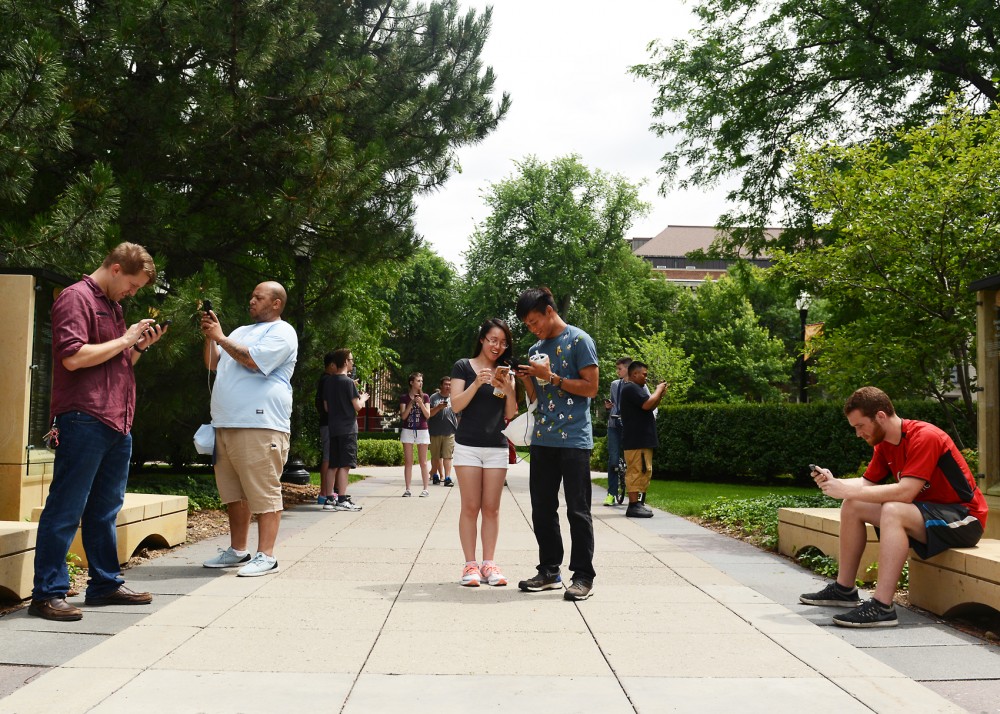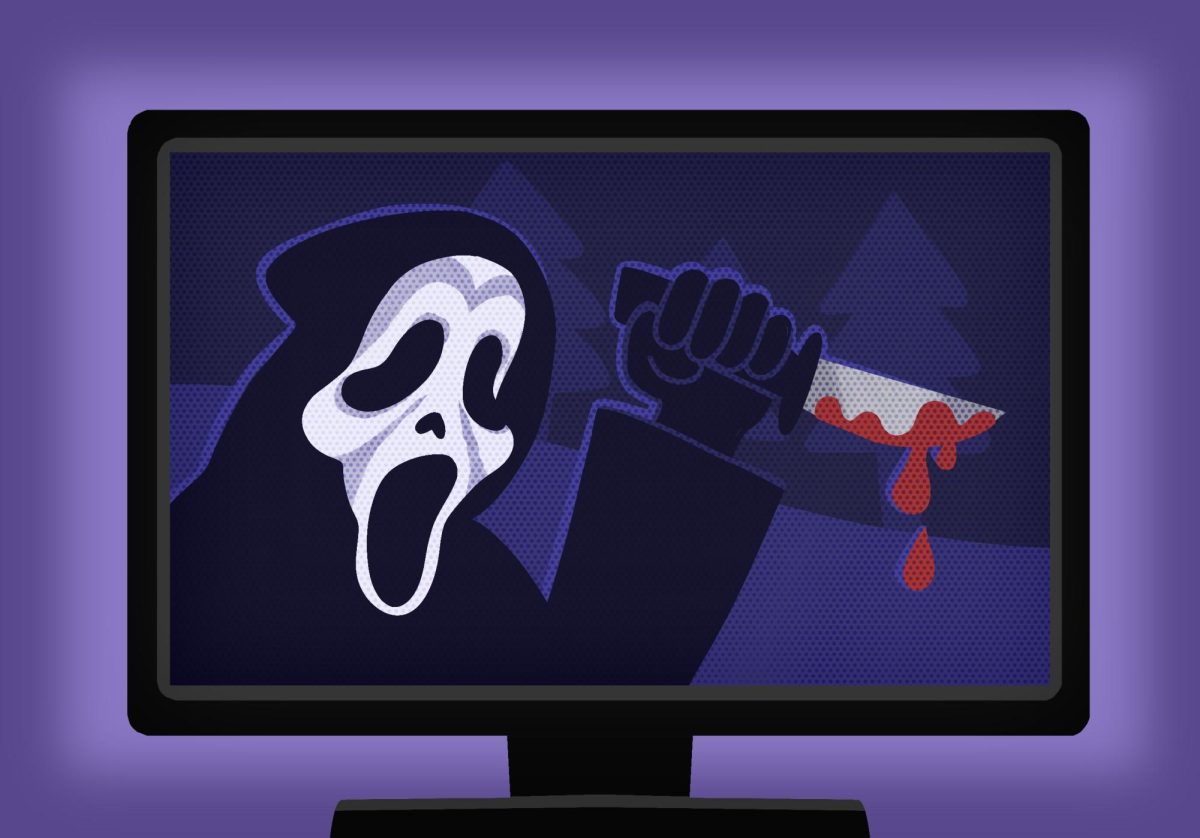On Sunday morning, the grounds surrounding Coffman Union were uncharacteristically silent, save for the casual dog-walker enjoying the solace of a quiet campus stroll.
A group of about 10 people milled about. They looked to be in their early 20s; a few wore Pikachu backpacks. Moving slowly in a pack, they stared at their phones — an image of the quintessential, tuned-in millennial that think-pieces love to pick.
All of a sudden, one glanced up.
“There’s a Nidoqueen over there!” he screamed, pointing toward what looked to be some nicely manicured shrubbery. They flew.
“Pokemon Go,” a new game for Android and iOS mobile devices, was released July 6 after being announced last September. The app is an augmented reality game in which players — trainers, as they are called in the Poke-verse — can find and capture Pokemon in the “real” world using their smartphones’ cameras, clock and GPS.
Once a certain level of expertise is reached within the game, trainers declare a team — red for Valor, blue for Mystic or yellow for Instinct — and can use the Pokemon they have captured to battle and control “gyms,” which are most often located at common city landmarks.
Twin Cities locals Tylor Oberstar-Cline and Nathan Walton downloaded the app as soon as it was released. They decided to make a Facebook event inviting their friends to hang out on the University of Minnesota campus on Sunday morning, searching for Pokemon and capturing the campus’ eight gyms for their team.
Not even thinking about it, they made the event public, and by Saturday evening more than 1.5 thousand people had expressed interest in attending the meet-up.
Oberstar-Cline and Walton sat on Coffman’s front steps feverishly discussing the game with a couple others — few of which had met prior to that morning. Among these people was Justin Mestler, who started playing Pokemon games at age six.
“[The meet-up] started as kind of a joke,” Walton’s friend Ellie Metz said, a Wisconsin native who extended her stay in the cities to attend.
“You don’t joke about Pokemon,” Mestler said.
Around 10:30 a.m., a half-hour after the event’s slated start time, Walton and Oberstar-Cline decided it was time to up the ante.
Walton stood on top of the Coffman Union steps; people stared up at him with their phones out and ready as he made the announcement that it was time to split into teams.
The group, which had been working together all morning to capture rare breeds, was suddenly divided. Valor and Mystic members discussed game plans under their breath, careful that the two Instinct team members did not overhear.
The groups set off across campus in search of gyms, water bottles in hands. Diverging from traditional video game formatting, “Pokemon Go” requires trainers to physically get up and walk around in order to play.
“Who needs a Fitbit? I’m going to lose at least three pounds today just doing this,” Mestler said.
Because trainers are forced to explore their surroundings, it’s not rare for two people who are playing to strike up a conversation, often deciding to pair up and capture some Pokemon together.
“I met a guy in his 40s and his kid,” I overheard someone say. “We all ran around together for like 45 minutes.”
People are not afraid of going out of their way for a rare catch; detours mean nothing if the possibility of taking over a gym exists.
Searching for the deeper meaning as to why the game is such a phenomenon, I asked Mestler to explain some key history to me. He couldn’t remember much off the top of his head — he watched the show so long ago.
“You don’t remember the details … just how you felt,” Mestler said, capturing an Abra on the first try as he spoke.
As the day went on, rumors swirled. People talked of trainers trespassing into backyards to catch a Voltorb. Someone heard that a cop had pulled a friend of a friend over for texting while driving — only to find out she was playing the game. The officer decided to download the app himself after further explanation.
The St. Paul Capitol, which is currently closed for renovations, has a Pokemon gym inside it. The public is not currently allowed inside the building, yet within 24 hours of the app’s release someone somehow had control of the locale.
Google Maps data is synced with the app, with local landmarks serving as places for trainers to congregate. Businesses have also caught onto the popularity of the app.
Post-release, Sencha Tea Bar in Stadium Village created a line of four drinks — three for each color team and one “Pikachu drink” so folks from opposing teams could come together to enjoy tapioca bubbles on common ground.
As the event quieted down, people congregated to Sencha for a pick-me-up. The app is a battery drainer, so the business had provided power strips across the floor. An instrumental Pokemon soundtrack played softly in the background.
At the counter, a girl ordered the Valor drink — a strawberry-cherry concoction.
“What? That’s not our team!”
“But it sounds good!”
I asked barista Josh Suwaratana why the business is offering these drinks. Is it because they knew they’d make money off of thirsty trainers?
“Honestly … we’re just all playing it too,” Suwaratana said.
At 1 p.m., everyone came together once again to hear the outcome of the day. As it stood, team Mystic had control of six of the campus’s gyms. Valor and Instinct each had one.
Though batteries were running low, the day was far from over. Another meet-up was coming together at the Mall of America, and trainers were eager to follow tips from earlier in the day.
You know how the saying goes — they “gotta catch ’em all.”








